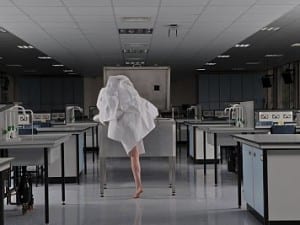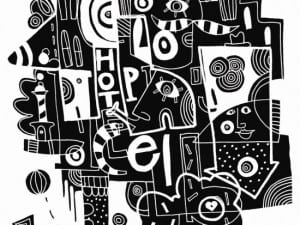Art history is replete with romantic mythologies, few more potent than the artist as obsessive maker, working round the clock in his studio or in the landscape, as was the case with one of modern art’s most famous obsessives, Paul Cezanne, around whom Magnus Quaife’s solo show, Like a Child Running a Stick Along a Fence at Works | Projects, is framed.
Quaife, as the accompanying literature has it, has transformed Works | Projects single room gallery into his own stripped-down version of Cezanne’s studio, replacing the grandfather of Modernism’s countless paintings of Mount Saint Victoire with his own large-scale sculpture of a similarly mountainous landscape.
The result is a structure topographically comparable to Cezanne’s mountain but equally evocative of Devil’s Mount, the fictional location featured in Steven Spielberg’s 1977 film Close Encounters of the Third Kind. It is this film’s main character Roy Neary, played by Richard Dreyfus, who provides the second ideological marker for this installation. The parallels between the two characters are clear: each driven by a power greater, perhaps, than his own comprehension, to recreate obsessively a mountainous location.
For Cezanne the mountain which overlooked his home town loomed large, and after a long spell in Paris he spent the subsequent 20 years painting it in oil and watercolour. Neary, on the other hand, is overcome by a sudden, inexplicable urge to model a volcano, first from his dinner of mashed potatoes, then from pieces of furniture and other household objects, until it overtakes the living room of his home in the same way that Quaife’s sculpture dominates the space here.
The central sculpture is fashioned from an improvised framework, spray-painted tablecloths, plants and other natural debris, and is large enough to hinder circumnavigation. It is surrounded by wall-mounted watercolour paintings of scenes from the film, as well as details from Cezanne’s life story and images torn from a Cezanne text book. The immaculate framing of these works demonstrates a tight control, which contrasts sharply with the apparent haphazard nature of Quaife’s mountain.
On the walls one image stands out over the others: a collage comprising the two mountains. A print of one of Cezanne’s Mount Saint Victoire oil paintings is overlapped by Devil’s Mount at the moment of its alien landing, evoking the image of Cezanne himself watching the closing scenes of Close Encounters of the Third Kind.
Through Magnus Quaife’s own endeavour, the obsessions of two characters – one fictional, one semi-mythologised in the earliest days of modern art – are pulled together to create one new whole work; but in revealing, between the work and the accompanying text, absolutely everything about this connection, Quaife has left nothing for the viewer to discover.
Because of that, Like a Child Running a Stick Along a Fence takes an interesting idea, which on first sight promises so much, and ends up hurrying the viewer towards its revelation. One can’t help but feel this exhibition might have been more rewarding had Quaife merely nudged us towards his big idea, rather than picking us up and taking us there.
Magnus Quaife: Like a Child Running a Stick Along a Fence, until 12 July, Works | Projects, Sydney Row, Bristol, BS1 6UU. For more information visit www.worksprojects.co.uk.
Trevor H Smith
Credits
1. Magnus Quaife, Like a Child Running a Stick Along a Fence. Courtesy of the artist.
Follow us on Twitter @AestheticaMag for the latest news in contemporary art and culture.





